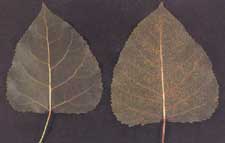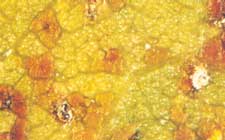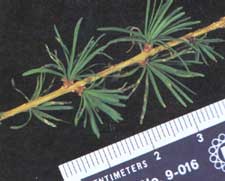Cottonwood Leaf RustsLouis Shain - Associate Professor of Plant Pathology, Department of Plant Pathology, University of Kentucky, Lexington, KY, and Cordell C.E., Anderson R.L., Hoffard W.H., Landis T.D., Smith R.S. Jr., Toko H.V., 1989. Forest Nursery Pests. USDA Forest Service, Agriculture Handbook No. 680, 184 pp. Hosts Two leaf rusts commonly attack cottonwoods in the United States. Rust of eastern cottonwood is caused by Melampsora medusae; M. occidentalis infects black cottonwood. Other poplars, including hybrids, are also susceptible to these two fungi. Infection of coniferous alternate hosts, mainly larch and Douglas-fir, is confined to young needles and usually is considered minor. Distribution Melampsora medusae is widely distributed in the United States, including Alaska. Melampsora occidentalis occurs from the Pacific Coast east to Wyoming and north to western Canada and Alaska. Damage Severe infection of cottonwood can lead to partial or complete defoliation by midsummer. Such high levels of infection adversely affect seedling vigor and quality. Diagnosis On cottonwood seedlings, look for orange-yellow uredinial pustules (fig. 30-1). These pustules rupture, releasing large numbers of powdery urediniospores. From late summer to autumn, smooth crusts of telia (fig. 30-2), yellowish darkening to brown, are produced among the uredinia.
The life cycles of both species are similar. Telia are produced on cottonwood leaves in the autumn. Teliospores overwinter on fallen leaves and germinate in the spring, producing basidiospores. The basidiospores infect the emerging needles of conifer hosts. The first fungal structures to appear on infected conifer needles are the pycnia. Pycniospores are associated with the sexual reproduction of these fungi and infect neither conifers nor poplars. Shortly after the pycnia appear, aecia develop on the infected needles. The aeciospores are unable to reinfect conifers. Carried by the wind, aeciospores infect cottonwood leaves. Uredinia, containing urediniospores, soon develop on infected leaves. These urediniospores reinfect only cottonwood. Under favorable conditions, the uredinia may develop within 1 week following infection, resulting in rapid buildup of the disease. Later in the growing season, telia are produced, completing the annual cycle. Because both the aeciospores and the urediniospores are wind-borne, infection of cottonwood can occur at considerable distances from conifer hosts. Uredinia and telia are colonized by a number of hyperparasites, particularly the fungus Darluca filum, which reduce the quantity of rust spores produced. Control Prevention - The use of clonal material selected for resistance offers the most promising means of prevention: however, growing a few resistant clones in extensive out-plantings is dangerous. In such plantings, selection pressure on the fungus would favor the buildup of pathogenic races. For this strategy to be successful, many resistant clones should be planted in mixture. Eradicate conifer hosts near nurseries or establish nurseries in areas distant from known conifer hosts to reduce the level of inoculum. In the South, remove nearby susceptible evergreen poplars to reduce the amount of overwintering uredinia. Chemical - Benomyl, applied at the onset of infection, has proven effective in controlling cottonwood leaf rusts. Selected References Filer, T.H. Jr. 1975. Melampsora rust on cottonwood. In: Peterson. Glenn W.; Smith. Richard S., Jr., tech. coords. Forest nursery diseases in the United States. Agric. Handb. 470. Washington, DC: U.S. Department of Agriculture: 99-100. Sham, L. 1976. Etiology, epidemiology, and control of Melampsora rust of cottonwood. In: Thielges. B.A.; Land, S.B., Jr., eds. Symposium on eastern cottonwood and related species: 1976 September 28-October 2; Greenville, MS. Baton Rouge, LA: Louisiana State University: 189- 198. Ziller, W.G. 1974. The tree rusts of western Canada. PubI. 1329. Victoria. BC: Canadian Forestry Service. 272 p. |
Forest Pests: Insects, Diseases & Other Damage Agents |

|
|




